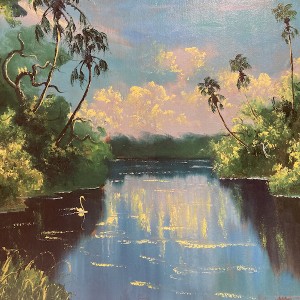“It’s rewarding to start with nothing and finish with something.” The question was about sculpting but the answer may as well be about everything else. Reclining on the couch in his Sarasota home, surrounded by the trappings of a happy family life (he will bring up his grandkids often) and mementos from his decades-long career as an artist—not to mention the house, the pool, the detached studio with covered walkway and the expanse of rolling green lawn, complete with a pond that looks suspiciously like the kind that has actual fish in it, that this career helped afford—Jack Dowd looks back on a whirlwind life of chainsaws, rock bands, surfing, entrepreneurship and art with a nonchalance that belies a man still of fierce vitality.
This grandfatherly figure is a far cry from the man previously seen smiling on the cover of Sarasota Style with gold-rimmed glasses and a tie that would make the 80s ask for more cocaine, but also a far cry from the 85 years he’s supposedly carrying these days. Still sculpting, his favorite piece is whatever he has in the studio at the moment. And as he gears up for Jack Dowd: Last Call, a new retrospective exhibition opening this June at Ringling College of Art & Design—and named after Dowd’s seminal sculptural achievement—he has one more trick up his sleeve: a musical.
Not kidding.

Though originally a painter—as well as a marine, a musician, a high school teacher, a surfer and co-owner of a bar called The Knotty Knee—Dowd finally broke through as an artist when he made the jump to life-size sculpture. It has since become his calling card. And he’s perhaps the only man who’s made money selling people a butler that does nothing and that they have to take care of. (He estimates that he’s sold well over 1,000 such sculptures.) This response is not something he seems to entirely understand, but he also doesn’t seem overly inclined to question this particular whim of the universe. “As soon as I started doing life-size sculptures, I started making money,” he says matter-of-factly. And that’s that.
When Last Call debuted in 2001 at the John & Mable Ringling Museum of Art, viewers’ eyes popped at the sheer magnitude of the thing. A full-scale recreation of a classic New York City tavern scene, the installation included a 22-foot mahogany bar and full backdrop, a kindly old barkeep frozen mid-pour and 12 life-size patrons seated at or standing around it all. Today, as the piece is reassembled in the Stulberg Gallery of Ringling College, the size still astounds, as does the detail of every hand-crafted character. And characters they are, not simply figures. Each has their own story, their own name. Dowd has given them all lives and dreams and favorite drinks. Some are inspired by old friends. Some are complete strangers. All are immortalized in Last Call.
“I wanted to do a sculpture of something I knew better than anybody,” Dowd says. The Knotty Knee had long ago spun off into a franchise of 11 more successful bars in the 70s and 80s, and it was a scene Dowd had become intimately familiar with and looked back on fondly. “I knew the stories I wanted to tell,” he says, “and these are the people I met over the years.”

The project took two years to complete. The bar alone was a feat in itself and Dowd enlisted the help of his son, Jon. They built the 22-foot mahogany expanse as 26 individual pieces, and designed it to be easily disassembled and transported. Sculpting the bar’s inhabitants was even more complicated. Each figure first required a series of reference photos, which meant each required a model. Some Dowd knew. One is Dowd. Still others he found on the street, such as the young woman who he approached in Central Park and eventually modeled as the Last Call’s waitress—once Dowd’s wife convinced her that he was in fact an artist.
From these reference photographs, Dowd would first sketch the figure on graph paper, capturing scale and measurements for the eventual sculpture. With those measurements as a guide, his son could then fabricate a metal armature of rebar, “like a skeleton,” that Dowd would wrap in an aluminum lathe—a wire mesh that builds shape and gives the clay something to bite into when Dowd begins sculpting in earnest. Using an oil-based clay that would never dry, he would work on each figure for weeks—months, in some cases—capturing every detail, from the lay of their hair to every wrinkle of their clothes, to his satisfaction. Only then would the sculpture be cast into a mold for the final resin figure.
After casting, Dowd breaks down the sculpture he just sweated over for weeks, reclaiming what clay and rebar he can, and it’s right on to the next. Dowd is not precious about his work in that way, and when he’s done with a sculpture, he’s done with it. “I just move on,” he says. “It’s like getting divorced.”

Which is an odd thing to say.
But it also helps explain why a supposed retrospective will also mark the (partial) debut of a whole new body of work from the artist: an original three-act musical inspired by the characters of Last Call. Featuring 13 original songs (co-written with Daniel Landers), the story centers around the redemptive romance of star-cross’d rockers Daniel and Sarah, who reunite by chance one night at the Last Call, but Dowd also uses the opportunity to explore the lives of his other characters and expand upon their stories. It’s a natural evolution of Dowd’s signature work that highlights its underlying humanity and a fervent belief that everyone, even the weirdos you’ll find at Last Call, has a story worth telling.
And that’s something.










